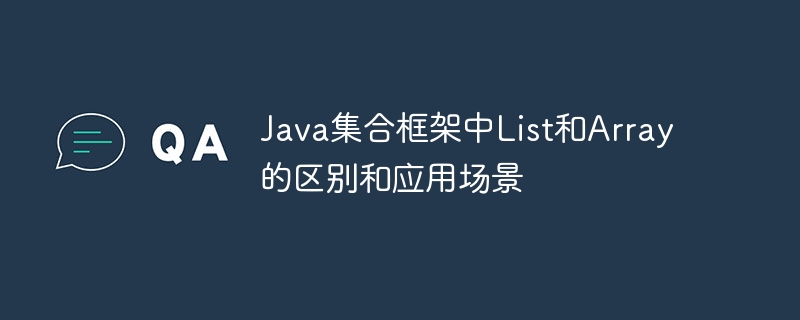 Java
Java
 javaTutorial
javaTutorial
 The difference and application scenarios between List and Array in Java collection framework
The difference and application scenarios between List and Array in Java collection framework
The difference and application scenarios between List and Array in Java collection framework
List and Array are two data structures in the Java collection framework, each with its own characteristics: Size: Array has a fixed size, and List has a variable size. Speed: Array is generally faster than List because of direct access to memory. Element type: Array must store elements of the same type, while List can store elements of different types. Flexibility and operations: Array has limited flexibility, but basic operations are faster; List is flexible and supports insertion, deletion, and update. Application scenarios: Array is suitable for situations where a fixed size is required and performance is critical, while List is suitable for situations where the collection size needs to be changed or advanced operations need to be performed.

List and Array in Java Collection Framework
The Java Collection Framework provides a wide range of collection types, including List and Array. Understanding their differences is critical to effectively managing data in your application.
Array
- is a fixed-length sequential collection that stores elements of the same type.
- Elements are accessed using zero-based indexing.
- Once created, its size cannot be changed.
- Generally faster than other collections due to direct memory access.
Code example:
int[] arr = new int[5]; arr[0] = 10; arr[1] = 20;
List
- is a variable-sized ordered collection .
- Allows insertion, deletion and update of elements.
- Supports traversal and random access to elements.
- More flexible than Array, but generally slower than Array because of the need for indirect memory access.
Code example:
List<String> list = new ArrayList<>();
list.add("Item 1");
list.add("Item 2");Difference
| Properties | Array | List |
|---|---|---|
| # #size | Fixed sizeVariable size | |
| Speed | Usually fasterUsually slower | |
| Element type | must be of the same typecan be of different types | |
| Flexibility | LimitedFlexible | |
| Operation | Basic operations (access, assignment)Insertion, deletion, update |
Application scenarios
Array:
- When a fixed-size collection of elements is required and performance is critical.
- For example, store an array of numbers of known length.
List:
- When the collection size needs to be changed or elements updated.
- For example, for managing a changing shopping list.
- When you need to support advanced operations (such as sorting, filtering).
The above is the detailed content of The difference and application scenarios between List and Array in Java collection framework. For more information, please follow other related articles on the PHP Chinese website!

Hot AI Tools

Undresser.AI Undress
AI-powered app for creating realistic nude photos

AI Clothes Remover
Online AI tool for removing clothes from photos.

Undress AI Tool
Undress images for free

Clothoff.io
AI clothes remover

AI Hentai Generator
Generate AI Hentai for free.

Hot Article

Hot Tools

Notepad++7.3.1
Easy-to-use and free code editor

SublimeText3 Chinese version
Chinese version, very easy to use

Zend Studio 13.0.1
Powerful PHP integrated development environment

Dreamweaver CS6
Visual web development tools

SublimeText3 Mac version
God-level code editing software (SublimeText3)

Hot Topics
 1376
1376
 52
52
 Square Root in Java
Aug 30, 2024 pm 04:26 PM
Square Root in Java
Aug 30, 2024 pm 04:26 PM
Guide to Square Root in Java. Here we discuss how Square Root works in Java with example and its code implementation respectively.
 Perfect Number in Java
Aug 30, 2024 pm 04:28 PM
Perfect Number in Java
Aug 30, 2024 pm 04:28 PM
Guide to Perfect Number in Java. Here we discuss the Definition, How to check Perfect number in Java?, examples with code implementation.
 Random Number Generator in Java
Aug 30, 2024 pm 04:27 PM
Random Number Generator in Java
Aug 30, 2024 pm 04:27 PM
Guide to Random Number Generator in Java. Here we discuss Functions in Java with examples and two different Generators with ther examples.
 Weka in Java
Aug 30, 2024 pm 04:28 PM
Weka in Java
Aug 30, 2024 pm 04:28 PM
Guide to Weka in Java. Here we discuss the Introduction, how to use weka java, the type of platform, and advantages with examples.
 Smith Number in Java
Aug 30, 2024 pm 04:28 PM
Smith Number in Java
Aug 30, 2024 pm 04:28 PM
Guide to Smith Number in Java. Here we discuss the Definition, How to check smith number in Java? example with code implementation.
 Java Spring Interview Questions
Aug 30, 2024 pm 04:29 PM
Java Spring Interview Questions
Aug 30, 2024 pm 04:29 PM
In this article, we have kept the most asked Java Spring Interview Questions with their detailed answers. So that you can crack the interview.
 Break or return from Java 8 stream forEach?
Feb 07, 2025 pm 12:09 PM
Break or return from Java 8 stream forEach?
Feb 07, 2025 pm 12:09 PM
Java 8 introduces the Stream API, providing a powerful and expressive way to process data collections. However, a common question when using Stream is: How to break or return from a forEach operation? Traditional loops allow for early interruption or return, but Stream's forEach method does not directly support this method. This article will explain the reasons and explore alternative methods for implementing premature termination in Stream processing systems. Further reading: Java Stream API improvements Understand Stream forEach The forEach method is a terminal operation that performs one operation on each element in the Stream. Its design intention is
 TimeStamp to Date in Java
Aug 30, 2024 pm 04:28 PM
TimeStamp to Date in Java
Aug 30, 2024 pm 04:28 PM
Guide to TimeStamp to Date in Java. Here we also discuss the introduction and how to convert timestamp to date in java along with examples.



